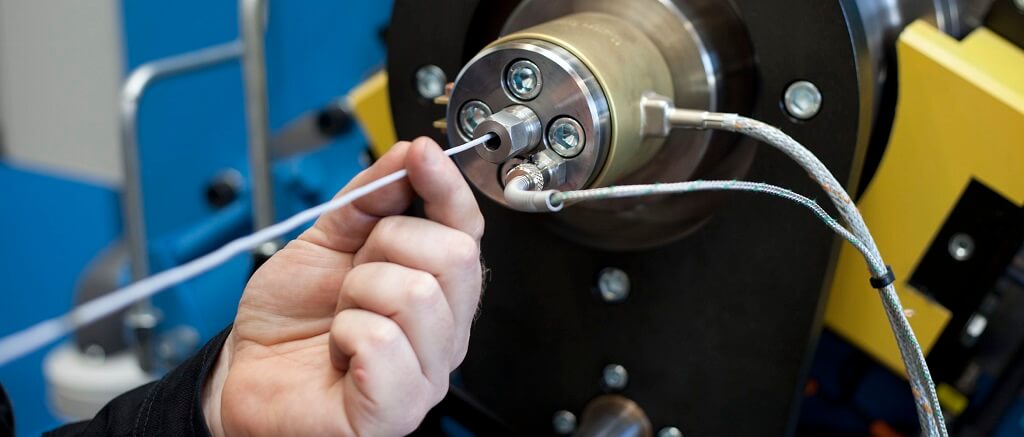The complete extrusion process of PTFE: Solid feeding section, Melting section, Diversion section, Melt conveying section and Cooling section.
1. Solid feeding section
In this section, the selection of materials is a very critical factor. In order to ensure the quality of extrusion, the materials used should meet the following conditions: high bulk density, good free flow, particles should have sufficient stability and hardness, and the raw materials Cleanliness, etc. Since the solid feeding section is divided into two processes, powder compaction and solid plug flow, the production process of this section should also be described from these two aspects.
①Powder compaction. In this section, when the plunger retreats, the loose material will fall into the punching chamber by itself under the action of gravity, and when the plunger gradually advances and begins to squeeze the material, the loose particles will Then it is compacted into a dense solid plug. This process is essentially the process of generating the extrusion pressure of the mechanical plunger.
②Solid plug flow. When the material continues to advance with the plunger, the solid plug will push the material in the entire barrel forward under the action of the punch. And in this process, the solid plug will receive the pushing force from the rear end and the front end and resistance, thereby storing a large amount of energy. When the plunger reaches the farthest stroke, it starts to retreat quickly. At this time, the material will release the previously stored energy, so that the material can continue to move forward. Because PTFE itself has large creep properties, when the plunger presses it down, a certain amount of energy will be stored due to deformation. This part of the energy will be gradually released as the plunger retreats, and this process will cycle Back and forth.

2. Melting section
When the solid plug advances, it will form friction with the barrel wall and generate heat. Coupled with the heater outside the barrel, the temperature of the solid plug will continue to rise, so that the material starts to melt and produce melting in the process. membrane. The melting of the material generally starts from the part closest to the cylinder wall, and gradually melts from the outside to the inside. As the material continues to advance, the thickness of the investment mold will also continue to increase, and the radius of the solid plug will be Keep getting smaller and smaller until the melt fills the entire barrel section.
3. Diversion section
Usually the beginning part of the pipe mold will have a shunt cone, its function is to make the melt flowing through this part form a thin ring, which helps to heat and plasticize and form a predetermined pipe. When the material flows through this section, the pressure will be built up in the melt under the frictional resistance of the splitter cone and other devices, which is beneficial to the formation of dense products, and the material will also be subjected to strong shear in this section. To a certain extent, the melting of the residual solid materials is accelerated, and the materials can basically become completely molten when they enter the next stage.
4. Melt conveying section
When the material enters this section, it has completely become a molten state, but the pressure has certain fluctuations, and the PTFE melt still has a certain degree of elasticity. This is because the material is always in the process of energy storage to discharge energy in the process of advancing. In order to ensure that the movement can continue; with the continuous advancement of the material, the pressure fluctuation will become smaller and smaller, and the movement will gradually become stable. Since the plunger punching extruder adopts a longer die design, it effectively extends the time that the material stays in the die, thereby further improving the uniformity and compactness of the product. Because of the high melting point of PTFE itself, it is necessary to heat the die during extrusion, and the length of the heating section will affect the extrusion pressure and speed to a certain extent, thereby affecting the processing efficiency of the extruder. According to relevant test results, the longer the heating section, the greater the extrusion pressure and the better the physical properties of the product. However, if the heating section is too long, it may cause cracks in the product. In order to solve this problem, the heating section of the barrel can be divided into three sections, each section can independently control the temperature, and an aluminum sleeve is added between the barrel and the electric heating ring, so that the balance of the surface temperature of the barrel can be ensured .
5. Cooling section
This section promotes the cooling and shaping of the material. During this process, the temperature of the material can be lowered below 250 ℃, and the requirement that the temperature is> 200 ℃ when the material is extruded from the thin-walled tube. Then, the pipe that is extruded from the thin-walled pipe needs to be cooled in the air to control the cooling time. It must be noted that if the cooling section is too short, the product will enter the air cooling stage in advance, which will cause the product to be too large in size, reduce the shrinkage rate, and increase the internal stress. In order to improve the quality of the product, the core rod should be appropriately larger than the length of the barrel to ensure that the core rod can play a good supporting role in the air cooling stage of the product.
Post time: Aug-13-2020

